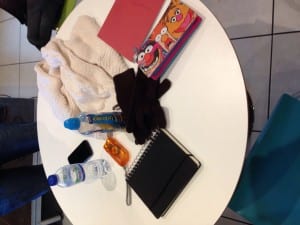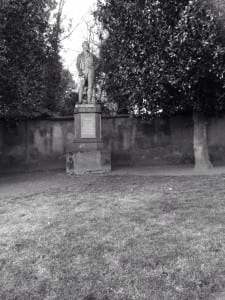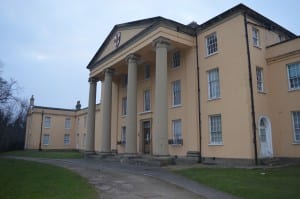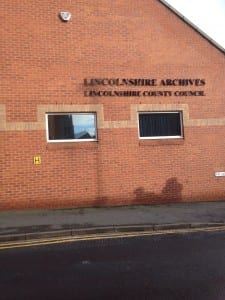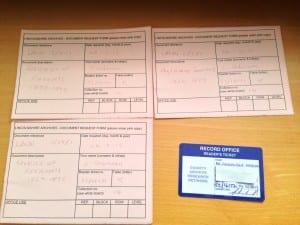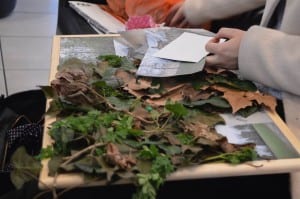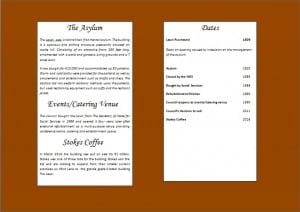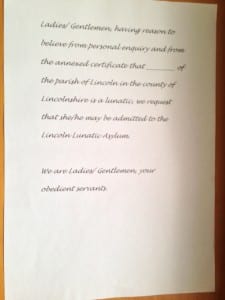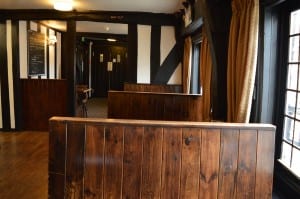The Madness Behind Coffee
Framing Statement
The aim of the assignment was to make a performance that will inform and educate people on their local history, whilst using a narrative to recount stories based around The Lawn, which was previously an insane asylum soon to become a new coffee roastery and museum.
Stories bring a connection to a site and give people a greater awareness of their surroundings. Children have their imaginations fired up and families share an experience they can relive each time they visit. People enter into the interpretation of a site and tell their own stories – recalling their past or taking flights of fantasy.
(The Journey Man, 2008)
The performance will be held in the coffee establishment that has recently purchased the building and grounds of The Lawn on 7th May 2015, shortly after building work has commenced at the site for its refurbishments. The performance will run between 15.30 until 18:00 depending on audience numbers and will last approximately 15 minutes from the audience member being greeted outside the coffee shop to them leaving after or with their hot beverage. ‘[S]pectator as ‘witness’ – a term often favoured in discussions of contemporary performance to suggest something more ethically involved that passive observation. (Bottoms, 2011, 463)
The whole performance shall be based around audio that will be played through headphones which can allow the audience member to become even more immersed in the performance being given. This concept has been adapted from some other site-specific theatre companies and performances, such as Since I Suppose by one step at a time like this, making the performance much more personal to each individual audience member.
Analysis of Process
Prepared for our ‘drift’ as best we had with our waterproofs, sensible shoes, note books and cameras ready to document the ‘opening up [of] the world’ (Mythogeography, 2015) (See Figure 1) that was promised, we initially were hesitant about how it would go due to four of the group living in Lincoln and all at different ends of the city. However we were more pessimistic that we would be lead somewhere where none of us were familiar with. It wasn’t long though before we were surprised that we had in fact achieved going to ‘places [we] wouldn’t normally visit’ (Mythogeography, 2015). Following the steeper paths in Lincoln, knowing none of us would ever take these paths in our everyday lives, warmed up and breathless we came to a imposing looking statue of a very dignified man, fenced into a small garden (See Figure 2) that seemed to lead to a much larger area of greenery preceding to a very grand looking building with columns at its entrance.
Following the fence up the road to find the entrance we were slightly taken aback to see a rundown looking building one side and a large modern hotel on the other with what appeared to be a public car park separating the two. Never the less we continued through and came to a large green with the grand building (See Figure 3) we saw before being at the back of the rundown building we had just past, this was where we wanted to perform.
‘A large part of the work has to do with researching a place, often an unusual one that is imbued with history or permeated with atmosphere’
(Pavis, 1998, 337)
Through our initial research on the building we found it was called The Lawn, a building that was one of countries first leading insane Asylums; which now due to its dilapidation, the people of Lincoln felt was an ‘embarrassment’ (Lincolnshire Echo, 2014). This straight away gave us images of a dark stone walled asylum which mistreated patients and being more like a torturous prison. Following up on this we then found out it was supposedly haunted:
There have been many reported sightings of ghostly figures, including those of children, roaming the corridors and grounds of the Lawn. They are said to wander round looking lost dressed in white robes. There are claims that these apparitions seem to be looking for something that the observers cannot see. Some have even reported hearing loud crying and wailing emanating from within its walls. Could these be the sounds of the troubled former inmates?
(Haunted History of Lincolnshire, 2015)
Intrigued by the information we found online and that it had repeatedly been put up for auction but always failed to sell, on the 4th February 2015 we decided to conduct research at the Lincolnshire Archives Lincolnshire County Council. After we all registered for the archive (as none of us had ever searched for anything in a county archive before) we were pleasantly surprised by the amount of information now open to use (See Figure 4). As Anya and Ellie looked through Register Restraints 1829-1832, Sam looked over Registers of Patients 1838-1895 and I found myself interested in Physicians Journals 1824-1827(See Figure 5)none of us could resist telling the others of the information we had found. We were all shocked however to learn that The Lawn was actually run:
With all the tenderness and indulgences compatible with the steady and effectual government of them and every occupation which my divert the mind, win [at the] tensions and awaken the affections be cheerfully and readily promoted.
(My City of Lincoln Story, 2015)
Entertainment for the patients was an important part of their treatment, and provision was made varying from the purchase of Dominos, a fox and goose board and draughts. […] of penny and a choice weekly magazines […] to music, dancing, cricket, quoits, football, bowls and croquet […] boating, picnics, special dances, theatrical performances, lectures and concerts.
(My City of Lincoln Blog, 2015)
This new insight into how the patients were treated affected our ideas for the performance a lot. We were originally thinking along similar lines to a ghost walk around the grounds, but after reading what we had, we felt it a better idea to go with a more sympathetic approach. As we began to write the scripts we decided that to add to the historical aspect of our performance we would include the real stories we had read at The Archive but in doing so we were posed with the question of how much could we adapt of which we had read? ‘[H]ow long do you have to have lived somewhere until you are allowed to lie about it? (Etchells, 1996, 51) reading this it posed to me the questions
Are we ever allowed to lie about a place when we’re trusted by an audience to pass on the information why wouldn’t we be allowed to lie? And if we did enough research into The Lawn as an institution then how much would we be able to fabricate the script of the performance whilst still keeping it true to the events that happened when it was still running?
(My City of Lincoln Story, 2015)
Never the less we decided to stick with what we had read with adding and adjust slight aspects of the stories more to fill in the gaps where areas in the journals could not be read and to make it easier for the audience to follow.
As we began the script and established characters we had to work out how we could make it so that their actions were performative. For my character of Dr Edward Parker Charlesworth who led the asylum and who ‘pioneered new ways of treating mental illness, without the use of restraint and barbaric methods to control patients’ (It’s About Lincoln, 2015). We thought it would be a reasonable idea for him to be writing out a letter while the audio is playing. We found the template for a letter at the archive that would be handed to the recently arriving patients confirming them as insane, we also though it would be a nice ‘souvenir’ for the audience to keep after the performance should they wish to.
On emailing the council however we found out that the site had recently been successfully sold at auction to ‘RW Stokes and Sons Ltd, the owners of Stokes Coffee and High Bridge Café in Lincoln’ (Lincolnite, 2014). Following this up with getting into contact with Stokes representative telling them of our plans and how we would like to make use of the space for its ‘great history and presence’ (Marshall, 2015), our response unfortunately informed us that although they liked our idea ‘the building and grounds [were] potentially going to be a building site for the next few months.’ (Peel, 2015) Initially seeing this as a major setback, after group discussion we realised this was actually a great opportunity as we could ‘adapt our piece to show The Lawn through the years and what it could potentially be in years to come’ (My City of Lincoln Story, 2015).
The idea was also suggested that on their arrival to the coffee shop, the audience member would be given a hot drink of their choosing, be it tea, coffee, hot chocolate, etc. As it would first just appear to be a nice gesture on our part to offer a complimentary drink but by the end of the performance they would realise how it links to asylum and everything else The Lawn was and would become.
We chose to move our performance from The Lawn to one of the current locations of Stokes Coffee on Lincoln’s High Street which trying to keep the ‘articulate exchanges between the work of art and the places in which its meanings are defined’ (Kaye, 2000). Due to the positive interest we got when first contacted, the company were more than happy for use to use their establishment. Our site was confirmed as the top floor of Stokes Café on 17th March, we began on reworking the script so that it could be performed in a more confined space and also to show the passing of time from 1824 through to the present day and into the future.
One issue we came across while scripting and recording our piece was how we could get across all the information we learned from the archive without just making the piece like a sort of information tour, reaming of fact and fact without any entertainment aspect. We felt it would be too much just to put it all into the audio tracks we were making and thought that with performing it now in the café where we could stick with the aesthetics of the space and have the information out in a newspaper.
After numerous discussions we began to find issues with using a newspaper as a tool for getting information across, the main problem being that due to our time scale, it would be very difficult for use to produce a realistic enough looking newspaper in terms of its quality and general thickness and amount of information and if it could not look real we did not want it. We tried out a couple of other ideas such as mood boards to show the different time periods of the lawn; one for it as an asylum, one as a derelict building leading into a council building and one for showing what it will become under the management of RW Stokes and Son. (See figure 6)
Regrettably though after the effort that went into making the first one, it straight away was clear that the mood boards would be too large for the tables we would be sat at in the café and similarly to the news paper, should we have them on a different table to the audience member, there would be no guaranty that they would even be looked at. We also thought about decorating a table cloth in a collage style with various bits of information on but again with the time frame we had we thought this was an unrealistic goal. Finally it was decided to set it out like a menu, in particular Stokes current coffee menu, replacing the headings of ‘Tea’, ‘Coffee’, ‘Snacks’ to ‘Asylum’, ‘Events/Catering Venue’ and ‘Stokes Coffee’(See Figure 7) and instead of names of drinks with prices we had important parts of Lawn history with dates by the side.
With everything prepared for the performance in terms of the setting we just had some final details to add onto the sound tracks, all of the script had been recorded, and due to some technical issues and background noise, it had be re-recorded to get it to the standard we wanted. It was still missing the atmosphere we desired though as it was just dialogue with wild tracks behind them, as we had read in the journals at the archive that patients would have been listening to music as a form of entertainment there, we thought it would be suiting that have similar music in the background of a couple of the character’s monologues. We didn’t want anything to well known or popular but through my library of music I was able to find piece which though not necessarily from the period were still in the style of it and also complimented the speeches really well. Having the music behind some of the tracks also helped some of the audio scenes to flow better from one to the other without any abrupt silences.
Recordings now already we were finally able to start rehearsing, it was left so close to the performance day that we were all very hesitant of how it would work with everyone’s timings but it had to be left so late due to constant changes with the recordings. On running it we straight away began to hit new issues, primarily with working out our timings, firstly on how long the audience member should be left to sit alone with their drink so they would have enough time to read our information menu and then if they didn’t would it seem to long just to be sat there without anything happening. After a few runs and a few more adjustments to the recordings we were finally ready for our performance.
Performance Evaluation
Though our audience numbers were not as large as we would have liked, due to our own lack of publicity, local weather issues, unavailability of the space until a set time and competing against other performances going on in the area, all the feedback received was very positive with very few criticisms. One aspect I found interesting was that each audience member reacting to each character different, something that had not been anticipated as we had never been able to test it with an audience first.
[S]pectators are usually conscious of their own status as spectators, and thus as people who may exercise ethical judgement […] we watch ourselves watching people engaging with an ethical problem while knowing that we are also being watched in our watching.
(Ridout, 2009, 15)
The biggest difference was with Ellie’s character of a mother who had lost her child, some audience members felt uncomfortable; some didn’t know whether to reply to the questions they hear her say, some did reply. It was very positive to see the audience get involved with the performance; it just was not what we had anticipated. Every audience member was also very pleased to have a letter confirming their insanity as a small memento of their experience, (See Figure 8)something we were all pleased had worked well with the audience.
An aspect I felt work very well was the aesthetic of the building itself complimenting the performance perfectly, due to spending a lot of my time working on the recordings, I hadn’t had chance to ever visit the site since it changed from The Lawn itself. The old Tudor style building work well to complement the time period we had started our piece, though obviously not a Tudor (See Figure 9) period but still old enough that the two would have coincided, it would have been a lot more distracting I feel if we had performed it in a modern café with laminate wood floors and base walls with slogans on.
If we had the chance to do it again, my main thoughts on improving it would be its length, in the end the performance was only just over 10 minutes when we could have gone up to 30. The only reason we did not go for a longer amount of time was because whatever we ended up with we wanted it to be a good quality so we spent a lot of time on the recordings making sure there was no white noise and wind sounds. If given the chance and time to do it again, I would like to add to what we already had.
The only real altercation I would make to the performances we did, taking on the feedback received would be to shorten the final piece of music on the audio and fade it towards the end rather then it just playing on until we physically came to stop it.
One thing I have really come to appreciate through doing this site-specific piece and through the readings I have done is the perimeter of space that one performs in. We set it in an insane asylum, council office space a coffee shop, but nearly the whole performance was done sat in a booth with a single audience member, it was very confined but very effective. This with the suited audio fitting each section helping to great the right atmosphere for each scene, rather than the usual atmosphere you would feel in a high street coffee chain.
Work Cited:
American Theatre Wing (2014) Working in the Theatre: Since I Suppose – Site Specific Theatre. [online video] Available from https://www.youtube.com/watch?v=WBN1a352cPY [Accessed 28 May 2015]
Bottoms, S. (2011) Materialising the Audience: Tim Crouch’s Sight Specifics in ENGLAND and The Author. Contemporary Theatre Review, 21 (4) 445-463.
Etchells, T. in Tushingham, D. (ed.) (1996) Live 4: Freedom Machine. London: Nick Hern Books.
Fitzgerald, A. (2015) [photograph]
Haunted History of Lincolnshire (2015) The Lawn. [online] Lincoln: University of Lincoln Blogs. Available from: https://hauntedhistoryoflincolnshire.blogs.lincoln.ac.uk/lincoln/the-lawn/ [Accessed 28 May 2015].
Its About Lincoln (2015) Lincoln Lunatic Asylum. [online] Lincoln: Angelic Aromas. Available from: http://www.itsaboutlincoln.co.uk/lincoln-lunatic-asylum.html [Accessed 28 May 2015].
Gillett, J. (2008) Site Specific Stories. [online] Chester: The Journey Man. Available from: http://www.thejourneyman.org.uk/site-specific-stories.html [Accessed 28 May 2015].
Kaye, N. (2000) Site-Specific Art: Performance, Place and Documentation. London and New York: Routledge.
Fish, E (2014) RW Stokes win bid to revamp The Lawn in Lincoln. [online] Lincoln: The Lincolnite. Available from: http://thelincolnite.co.uk/2014/11/stokes-coffee-win-lincoln-lawn-bid/ [Accessed 28 May 2015].
Lincolnshire Echo. (2014) ‘Embarrassing’ Lincoln landmark The Lawn to go back on sale. [online] Lincoln: Lincolnshire Echo. Available from: http://www.lincolnshireecho.co.uk/Embarrassing-Lincoln-landmark-Lawn-sale/story-20767634-detail/story.html [Accessed 28 May 2015].
Marshall, A. (2015) [photograph]
Marshall, A. (2015) Performance at the Lawn. [email] Sent to Nick Peel, 17 February.
My City of Lincoln Story (2015) Archieve – Samuel Robinson. [blog entry] 10 February. Lincoln: Lincs to the Past. Available from https://sitespecific2015ksa.blogs.lincoln.ac.uk/2015/02/10/achieve-samuel-robinson/ [Accessed 28 May 2015].
My City of Lincoln Story (2015) The Lawn its Problems!. [blog entry[ 19 February. Lincoln: Lincs to the Past. Available from https://sitespecific2015ksa.blogs.lincoln.ac.uk/2015/02/19/the-lawn-its-problems/ [Accessed 29 May 2015].
My City of Lincoln Story (2015) Lincolnshire Archive by Anya Fitzgerald. [blog entry] 4 February. Lincoln: Lincs to the Past. Available from https://sitespecific2015ksa.blogs.lincoln.ac.uk/ [Accessed 28 May 2015].
My City of Lincoln Story (2015) The Lawn – Lincoln Archive – Alex Marshall. [blog entry] 6 February. Lincoln: Lincs to the Past. Available from https://sitespecific2015ksa.blogs.lincoln.ac.uk/2015/02/06/the-lawn-lincoln-archive-alex-marshall/ [Accessed 28 May 2015].
Mythogeography (2015) Starter Kit. [online] Publication unknown. Available from: http://www.mythogeography.com/starter-kit.html [Accessed 28 May 2015].
Pavis, P. (1998) Dictionary of the Theatre: Terms, Concepts and Analysis. Toronto: University of Toronto Press.
Peel, N. (2015) Performance at the Lawn. [email] Sent to Alexander Marshall, 18 February.
Ridout, N. (2009) Theatre & Ethics. Basingstoke: Palgrave Macmillan.
Robinson, S. (2015) [photograph]
